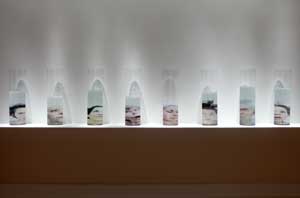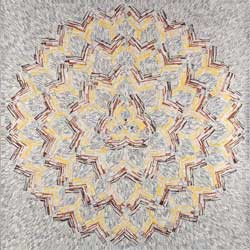Strange Alchemy
By Eric D. Bookhardt, GAMBIT WEEKLY

Glass Test Tube: Experiment, 2010, by Dawn Dedeaux
The objects on view are all too familiar, though not necessarily reassuring. Wrecking balls, ladders and water, lots of water, offer no end of troubling associations — and not just for local associations. Those same images also resonate in the wake of the recent horrific flooding in Japan, but in Dawn Dedeaux’s Unseen expo, they attain an eerie quality of detachment. A wrecking ball hanging from a huge chain evokes an oracular omen of sorts, while ghostly ladders crafted from clear Lucite suggest platonic or even semi-celestial forms. The severed links of anchor chains lying on, or rising from, the floor also are tipped with clear Lucite in an intimation of dense matter suddenly transformed into something more like light. This near-metaphysical mixing of metaphors is especially evident in some glass cylinders with photographic portraits — headshots — seemingly fused into the glass. Filled with water, which functions like a distortion lens, they have a strange undulating quality, yet their slightly bewildered expressions dispel the more obvious associations of drowning in favor of something more otherworldly. Like the other works, they intimate mortality while touching on mystery, as if beyond the turmoil of the unspeakable there lies the possibility of wonder, or perhaps even grace.

Schnapps 70, 2010, by Troy Dugas
In the art world, logos and labels are ordinarily the realm of pop art, which at its best provides wry social commentary while making banality seem like fun. In the hands of Acadiana artist Troy Dugas, however, they morph into strange tapestries and marvelous mandalas that come across as ethereal if not mystical. Flame #1 is reminiscent of the sacred pyres of the Zoroastrians, and only up close does it become clear that it was cobbled together from shredded whiskey labels. Others recall the intricate sacred arabesques of the Sufis, Hindus, and even the symbolism of the Kabala, in a graphical iteration of the medieval alchemists” attempts to transform lead into gold, only here banality is transmuted into beauty and beyond.
